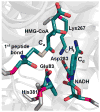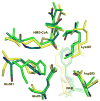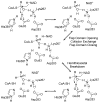Molecular modeling of the reaction pathway and hydride transfer reactions of HMG-CoA reductase
- PMID: 22971202
- PMCID: PMC3522576
- DOI: 10.1021/bi3008593
Molecular modeling of the reaction pathway and hydride transfer reactions of HMG-CoA reductase
Abstract
HMG-CoA reductase catalyzes the four-electron reduction of HMG-CoA to mevalonate and is an enzyme of considerable biomedical relevance because of the impact of its statin inhibitors on public health. Although the reaction has been studied extensively using X-ray crystallography, there are surprisingly no computational studies that test the mechanistic hypotheses suggested for this complex reaction. Theozyme and quantum mechanical (QM)/molecular mechanical (MM) calculations up to the B3LYP/6-31g(d,p)//B3LYP/6-311++g(2d,2p) level of theory were employed to generate an atomistic description of the enzymatic reaction process and its energy profile. The models generated here predict that the catalytically important Glu83 is protonated prior to hydride transfer and that it acts as the general acid or base in the reaction. With Glu83 protonated, the activation energies calculated for the sequential hydride transfer reactions, 21.8 and 19.3 kcal/mol, are in qualitative agreement with the experimentally determined rate constant for the entire reaction (1 s(-1) to 1 min(-1)). When Glu83 is not protonated, the first hydride transfer reaction is predicted to be disfavored by >20 kcal/mol, and the activation energy is predicted to be higher by >10 kcal/mol. While not involved in the reaction as an acid or base, Lys267 is critical for stabilization of the transition state in forming an oxyanion hole with the protonated Glu83. Molecular dynamics simulations and MM/Poisson-Boltzmann surface area free energy calculations predict that the enzyme active site stabilizes the hemithioacetal intermediate better than the aldehyde intermediate. This suggests a mechanism in which cofactor exchange occurs before the breakdown of the hemithioacetal. Slowing the conversion to aldehyde would provide the enzyme with a mechanism to protect it from solvent and explain why the free aldehyde is not observed experimentally. Our results support the hypothesis that the pK(a) of an active site acidic group is modulated by the redox state of the cofactor. The oxidized cofactor and deprotonated Glu83 are closer in space after hydride transfer, indicating that indeed the cofactor may influence the pK(a) of Glu83 through an electrostatic interaction. The enzyme is able to catalyze the transfer of a hydride to the structurally and electronically distinct substrates by maintaining the general shape of the active site and adjusting the electrostatic environment through acid-base chemistry. Our results are in good agreement with the well-studied hydride transfer reactions catalyzed by liver alcohol dehydrogenase in calculated energy profile and reaction geometries despite different mechanistic functionalities.
Figures














Similar articles
-
Identification of the principal catalytically important acidic residue of 3-hydroxy-3-methylglutaryl coenzyme A reductase.J Biol Chem. 1990 Dec 15;265(35):21634-41. J Biol Chem. 1990. PMID: 2123872
-
Energetically most likely substrate and active-site protonation sites and pathways in the catalytic mechanism of dihydrofolate reductase.J Am Chem Soc. 2001 Apr 18;123(15):3418-28. doi: 10.1021/ja0038474. J Am Chem Soc. 2001. PMID: 11472112
-
Reaction-path energetics and kinetics of the hydride transfer reaction catalyzed by dihydrofolate reductase.Biochemistry. 2003 Nov 25;42(46):13558-75. doi: 10.1021/bi034824f. Biochemistry. 2003. PMID: 14622003
-
The structure of the catalytic portion of human HMG-CoA reductase.Biochim Biophys Acta. 2000 Dec 15;1529(1-3):9-18. doi: 10.1016/s1388-1981(00)00134-7. Biochim Biophys Acta. 2000. PMID: 11111074 Review.
-
The increasingly complex mechanism of HMG-CoA reductase.Acc Chem Res. 2013 Nov 19;46(11):2416-26. doi: 10.1021/ar3003267. Epub 2013 Jul 30. Acc Chem Res. 2013. PMID: 23898905 Free PMC article. Review.
Cited by
-
Mechanistic study of L-6-hydroxynicotine oxidase by DFT and ONIOM methods.J Mol Model. 2021 Jan 28;27(2):53. doi: 10.1007/s00894-020-04646-4. J Mol Model. 2021. PMID: 33507404
-
Synthesis of Caged HMG-CoA Reductase Substrates for the Elucidation of Cellular Pathways.J Org Chem. 2024 Dec 20;89(24):18739-18745. doi: 10.1021/acs.joc.4c02403. Epub 2024 Dec 6. J Org Chem. 2024. PMID: 39642078
-
A novel role for coenzyme A during hydride transfer in 3-hydroxy-3-methylglutaryl-coenzyme A reductase.Biochemistry. 2013 Aug 6;52(31):5195-205. doi: 10.1021/bi400335g. Epub 2013 Jul 24. Biochemistry. 2013. PMID: 23802607 Free PMC article.
-
A fungal tolerance trait and selective inhibitors proffer HMG-CoA reductase as a herbicide mode-of-action.Nat Commun. 2022 Sep 22;13(1):5563. doi: 10.1038/s41467-022-33185-0. Nat Commun. 2022. PMID: 36137996 Free PMC article.
-
pH-dependent reaction triggering in PmHMGR crystals for time-resolved crystallography.Biophys J. 2024 Mar 5;123(5):622-637. doi: 10.1016/j.bpj.2024.02.003. Epub 2024 Feb 6. Biophys J. 2024. PMID: 38327055 Free PMC article.
References
-
- Feng LL, Zhou L, Sun Y, Gui J, Wang XF, Wu P, Wan J, Ren YL, Qiu SX, Wei XY, Li J. Specific inhibitions of annonaceous acetogenins on class II 3-hydroxy-3-methylglutaryl coenzyme A reductase from Streptococcus pneumoniae. Bioorg Med Chem. 2011;19:3512–3519. - PubMed
-
- Li D, Gui J, Li Y, Feng L, Han X, Sun Y, Sun T, Chen Z, Cao Y, Zhang Y, Zhou L, Hu X, Ren Y, Wan J. Structure-Based Design and Screen of Novel Inhibitors for Class II 3-Hydroxy-3-methylglutaryl Coenzyme A Reductase from Streptococcus Pneumoniae. J Chem Inf Model. 2012;52:1833–1841. - PubMed
Publication types
MeSH terms
Substances
Grants and funding
LinkOut - more resources
Full Text Sources
Miscellaneous

